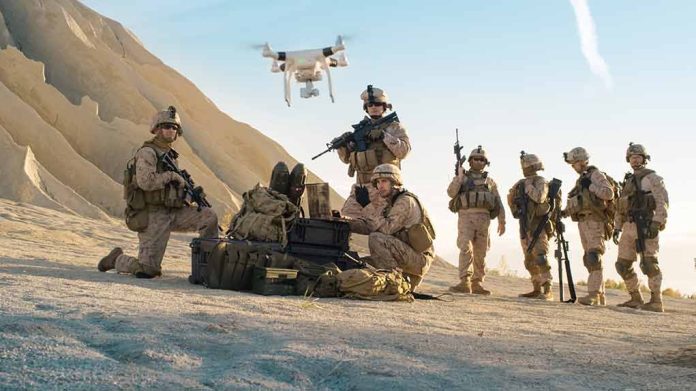
A top Russian military official in occupied Crimea has fatally shot himself in a panic during Ukraine’s increasingly effective drone onslaught, revealing critical weaknesses in Russia’s defense strategy.
Key Takeaways
- Sergei Tokarev, head of the military medical commission of Sevastopol’s Ministry of Internal Affairs, accidentally shot himself in the head while responding to Ukrainian drone attacks
- Massive Ukrainian drone campaigns have successfully targeted multiple strategic Russian military sites in Crimea, including key airfields at Saky, Kacha, and Dzhankoi
- Russian defenses claimed to intercept 524 Ukrainian drones in a 24-hour period, yet evidence shows successful strikes on critical military infrastructure
- The drone campaign has severely disrupted Russian civilian aviation, stranding approximately 60,000 passengers and affecting 350 flights across major Russian cities
- The accidental death highlights the psychological impact and defensive vulnerabilities created by Ukraine’s persistent drone strategy in occupied territories
Fatal Panic During Drone Barrage
The Russian occupation in Crimea suffered an unexpected casualty when Sergei Tokarev, head of the military medical commission of Sevastopol’s Ministry of Internal Affairs, accidentally killed himself during a Ukrainian drone attack. According to reports, Tokarev armed himself with a pistol and ventured outside his home during an air raid alarm, intending to defend against approaching drones. In his state of panic, he accidentally discharged the weapon, fatally shooting himself in the head. This tragic incident occurred amid a sophisticated and concentrated Ukrainian drone offensive targeting multiple Russian military installations across the peninsula.
“The head of the military medical commission of Sevastopol’s Ministry of Internal Affairs died after accidentally shooting himself in the head during a massive drone attack,” reported the Astra Telegram channel.
Strategic Infrastructure Under Fire
The Ukrainian drone campaign has proven remarkably effective at targeting key Russian military sites in occupied Crimea. On May 2, 2025, a massive drone assault struck multiple strategic locations, with explosions reported at Sevastopol, Dzhankoy, Saky, Novofedorivka, and Kacha – all hosting critical Russian military airfields. These bases are particularly valuable to Russia’s operational control over the Black Sea and serve as launch sites for attacks against Ukraine. Despite Russian claims of intercepting 89 Ukrainian drones over Crimea and an additional 23 over the Black Sea, video evidence showed multiple explosions and fires near several targeted facilities.
“The fleet, in cooperation with air defense forces, is reflecting a massive combined attack,” said Mikhail Razvozhayev the Russian-installed leader in Sevastopol.
The Russian Ministry of Defense’s insistence that they destroyed 524 Ukrainian drones in a single 24-hour period underscores the massive scale of Ukraine’s drone campaign. However, the visible damage at targeted sites suggests significant defensive failures despite these claims. Eyewitness reports and social media posts documented explosions near airbases in Saky, Kacha, Hvardiiske, and Dzhankoi, with additional secondary detonations observed near the Belbek facility, indicating successful strikes on ammunition or fuel depots.
Nationwide Disruption and International Fallout
The impact of Ukraine’s drone strategy extends far beyond military targets in Crimea, creating widespread civilian disruption across Russia. Approximately 60,000 passengers found themselves stranded at Russian airports as Ukrainian drone activities prompted security shutdowns, affecting 350 flights in Moscow, St. Petersburg, Sochi, and other major cities. This disruption occurred during a politically sensitive period as Moscow prepared for a World War Two victory parade, with 27 world leaders expected to attend, including Chinese President Xi Jinping.
“We think they [Russians] are asking for too much,” stated US Vice-President JD Vance, addressing Russia’s proposal for a limited three-day ceasefire that Ukraine rejected. “It’s very important for the Russians and the Ukrainians to start talking to one another.”
The psychological impact of Ukraine’s drone campaign cannot be overlooked, as evidenced by Tokarev’s fatal panic response. Continuous air raid sirens, unpredictable explosions, and the constant threat of attack have created an atmosphere of anxiety throughout occupied territories. As one Kyiv-based journalist, Dennis Kazanksy, observed on social media: “This is the most unexpected effects of a drone I have ever heard about.” The tragic self-inflicted casualty illustrates how psychological pressure can become as damaging as direct military action, particularly for occupation forces under persistent threat.
Strategic Implications and Future Operations
Ukraine’s persistent drone strategy has systematically exposed vulnerabilities in Russia’s occupation of Crimea, degrading both military capabilities and morale. Previous successful attacks have significantly impacted the Russian Black Sea Fleet, limiting Russia’s naval operations and creating defensive paranoia. Military analysts expect Ukraine to continue these high-value precision drone campaigns against Russian infrastructure, particularly focused on command centers, ammunition depots, and airfields that support operations against Ukrainian territory.
President Trump’s administration has pressured both sides toward diplomatic engagement while continuing to support Ukraine’s defensive capabilities. The drone campaign demonstrates Ukraine’s ability to project power into Russian-occupied territories despite resource constraints, establishing asymmetric leverage in any future negotiations. As the tragic case of Sergei Tokarev demonstrates, the psychological and operational costs of maintaining the Crimean occupation continue to mount for Russia, challenging the sustainability of their position as Ukraine maintains pressure through sophisticated drone warfare.














